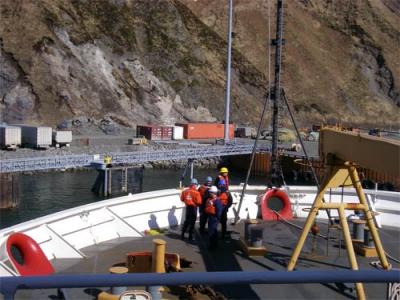The morning went well and I actually woke up without an alarm in time for breakfast. After some cereal and some hot tea, it was off to a brainstorming session with David Hyrenbach, a seabird specialist, and fellow PolarTREC and NOAA Teacher-at-Sea, Maggie Prevenas. We laid out our plan of action and it was amazing how in just a day how many scientists we had met and could connect them to their research they were hoping to accomplish on this expedition.

USCG Healy and crew leaving port and heading out into the Bering Sea
In just three hours after leaving the port, the first sampling station had been reached. The excitement of the scientists was contagious as well as their nervousness of whether all the equipment that they had set-up would work. Just prior to officially dropping the CTDA research tool that is submerged in the water to measure conductivity (salinity), temperature, and depth. into the water, all personnel from the science party were briefed on some basic safety of the Healy. This included discussion of what to do in case of abandoning ship, fire safety, medical, and other basic drills on board.
After the briefing, the scientists were off to test out the CTDA research tool that is submerged in the water to measure conductivity (salinity), temperature, and depth.. Most of the seal scientists stayed in the science lounge and began working on email and setting up their accounts. I stayed and continued to work on my journals. My roommate, Nancy, will be working the 12AM-12PM shift and is beginning to start easing into it by taking a long nap and waking around the time I will be heading to bed. Eventually, I will probably see her only in the mornings when I am down in the science labs and then I will work on staying out of the room so she can sleep.


Comments